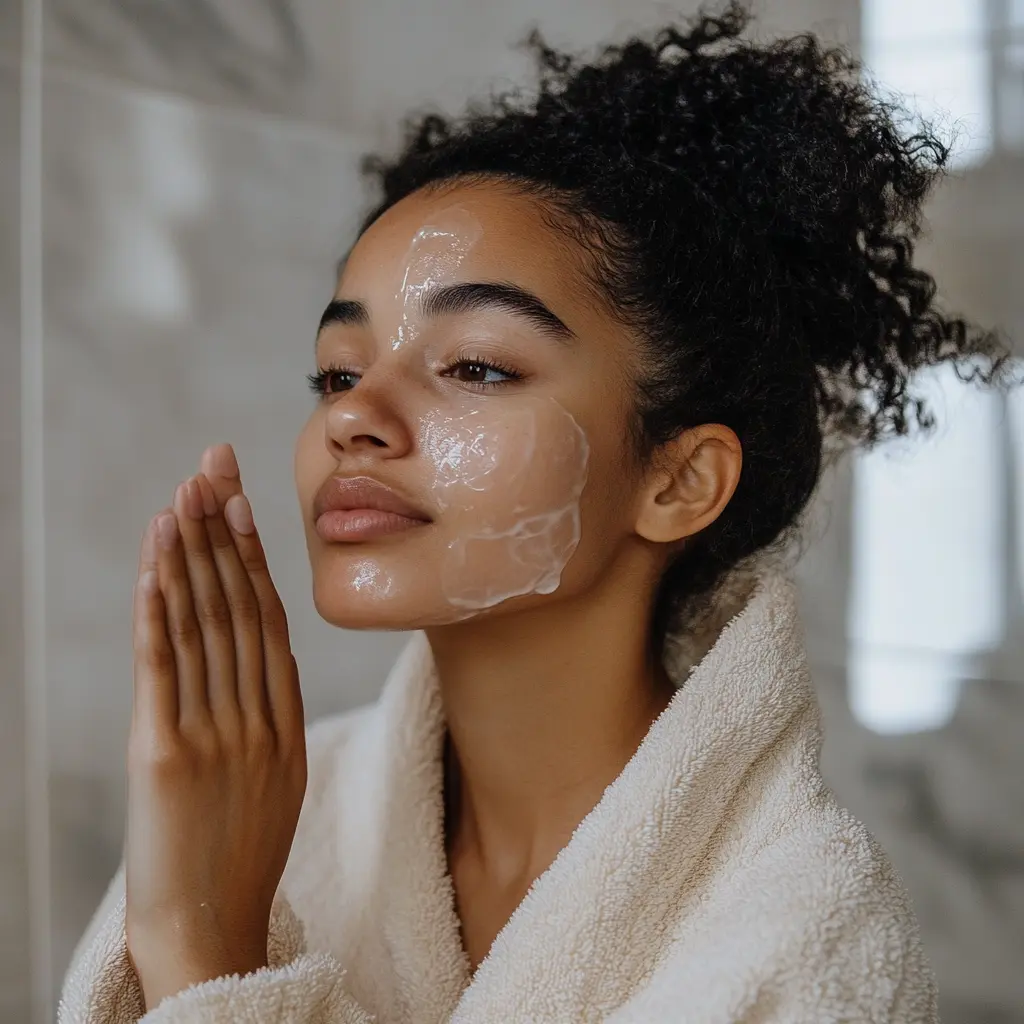Ever feel like your skincare routine is a bit of a mystery? You’re not alone. With so many products—serums, toners, moisturizers, and more—it’s easy to wonder if you’re using them in the right order. And yes, the sequence matters! Learning how to layer skincare products correctly can be the difference between glowing skin and wasted money.
Think of your skincare routine as a recipe. Just like you wouldn’t put frosting on a cake before baking the batter, you shouldn’t layer thick creams before lightweight serums. Each product has a job, and understanding how to layer skincare products properly is the secret to unlocking their full potential.
In this guide, we’ll break down the art of layering skincare into simple steps. From what goes on first to the ingredients that pair well (and the ones that don’t), you’ll get all the tips you need to create a routine that actually works. Let’s get started!
Table of contents
Why Does the Order of Skincare Products Matter?
Think of your skincare routine like assembling a sandwich. You wouldn’t put the bread on top of the lettuce before the meat—it wouldn’t make sense! Similarly, in skincare, the order of application matters because each product is designed to work in a specific way and on a specific layer of your skin. Applying products in the wrong sequence can make them less effective or even cause irritation. This is why understanding how to layer skincare products is so important for maximizing their benefits.
For example, if you apply a thick moisturizer before a lightweight, water-based serum, the moisturizer will create a barrier, making it nearly impossible for the serum to penetrate your skin. The result? Your serum—packed with all those amazing active ingredients—won’t deliver its benefits. By layering skincare products correctly, you ensure that every product does its job, from hydrating to protecting, without any interference.
Understanding the Skin Barrier and Product Absorption
Your skin is like a security guard, protecting you from external threats. While this is great for keeping out harmful bacteria and pollutants, it also means your products have to work extra hard to get where they need to go. This is where the correct way to layer skincare products becomes crucial.
Lighter, water-based products (like toners and serums) have smaller molecules that can slip into your skin more easily. These go first to deliver hydration or active ingredients. Heavier products, like oils and creams, have larger molecules that sit on top of your skin, locking in moisture and creating a barrier. Think of this sequence as working with your skin’s natural structure, not against it—giving your routine the best chance to deliver visible results.
The bottom line? When you respect your skin’s natural functions and layer skincare products in the right order, your products can do what they’re meant to do: nourish, treat, and protect!
How to Layer Skincare Products Like a Pro? Step-by-Step
When it comes to How to Layer Skincare Products Like a Pro?, following the right order is the key to maximizing the benefits of each product. Let’s dive deeper into each step to help you layer like a pro and take your skincare game to the next level.
Step 1: Cleanser – Your Starting Point
Cleansing is the cornerstone of any skincare routine. It removes dirt, oil, makeup, and sunscreen, ensuring the products you apply later can penetrate your skin effectively.
Morning Routine:
Kickstart your day with a gentle cleanser to wash away overnight sweat, oil, and any leftover residue from your nighttime skincare. Look for cleansers with soothing ingredients like aloe vera or green tea extract for a refreshing cleanse.
Evening Routine:
If you’ve worn sunscreen or makeup during the day, double cleansing is a must.
- Step 1: Start with an oil-based cleanser. This breaks down makeup, SPF, and excess sebum.
- Step 2: Follow up with a water-based cleanser to deep-clean pores and remove remaining impurities.
Pro Tip:
Avoid cleansers with harsh sulfates that can strip your skin of its natural oils. Instead, opt for ones that contain glycerin or ceramides for a more hydrating cleanse.
Step 2: Toner – The Prep Step
Toners might seem optional, but they play a vital role in prepping your skin for the next steps. They restore your skin’s natural pH balance and enhance the absorption of serums and moisturizers.
Hydrating Toners:
Perfect for dry or dehydrated skin, hydrating toners are packed with ingredients like hyaluronic acid, rose water, or panthenol to give your skin a moisture boost.
Exfoliating Toners:
Designed to slough off dead skin cells, exfoliating toners often contain active ingredients like glycolic acid (for glowing skin) or salicylic acid (for acne-prone skin). Use these 2–3 times a week at night, depending on your skin’s tolerance.
What to Avoid:
Never layer exfoliating toners with strong actives like retinoids or vitamin C in the same routine. This combo can cause redness, irritation, and sensitivity.
Step 3: Serum – The Treatment Powerhouse
Serums are where the magic happens. These concentrated formulas target specific skin concerns, from acne to aging.
Morning Serums:
Protect your skin from environmental damage with antioxidants like vitamin C or niacinamide. These ingredients neutralize free radicals and brighten your complexion.
Evening Serums:
At night, focus on repair. Look for serums with retinol (to boost cell turnover) or peptides (to support collagen production).
Perfect Pairings:
- Retinol + Hyaluronic Acid: Retinol can dry out your skin, but hyaluronic acid helps keep it hydrated.
- Vitamin C + Ferulic Acid: This duo amplifies antioxidant protection and enhances your glow.
What to Avoid:
Avoid combining retinol with vitamin C or benzoyl peroxide—they can clash and lead to irritation. Instead, alternate their use between morning and night.
Step 4: Moisturizer – Seal It In
Moisturizers are the unsung heroes of any skincare routine. They lock in hydration, strengthen your skin barrier, and create a smooth canvas for makeup.
Lightweight Gel Moisturizers:
Ideal for oily or acne-prone skin, gel moisturizers are lightweight, non-greasy, and absorb quickly. Look for ones with niacinamide or tea tree oil for added benefits.
Rich Creams:
Dry or mature skin will love thicker creams with nourishing ingredients like shea butter, ceramides, or squalane.
Pro Tip:
Apply moisturizer while your skin is still damp from your toner or serum. This helps seal in moisture and gives your skin a plumper, dewier look.
Step 5: Sunscreen – Your Daily Must-Have
If there’s one step you should never skip, it’s sunscreen. It protects your skin from harmful UV rays that cause premature aging, hyperpigmentation, and even skin cancer.
Chemical Sunscreens:
These absorb UV rays and convert them into heat, which is then released from the skin. Apply directly to clean, dry skin for the best protection.
Physical Sunscreens:
Also known as mineral sunscreens, they sit on top of the skin and physically block UV rays. Look for ingredients like zinc oxide or titanium dioxide, especially if you have sensitive skin.
Reapplication Tip:
SPF doesn’t last all day. Reapply every two hours, especially if you’re outside, sweating, or swimming. For easy reapplication, try a powder or spray sunscreen.
Step 6: Optional Add-Ons (But Worth It!)
If you’re feeling extra, here are a few optional steps to elevate your skincare routine:
Eye Cream:
The skin around your eyes is delicate and prone to fine lines. Use an eye cream with caffeine (for puffiness) or retinol (for wrinkles) before your moisturizer.
Facial Oils:
Seal in moisture with a few drops of facial oil. These are especially great for dry or mature skin. Apply them as the last step before SPF in the morning or after moisturizer at night.
Masks:
Once or twice a week, treat your skin to a mask. Choose a clay mask for oily skin, a hydrating sheet mask for dry skin, or an exfoliating mask for dull skin.
Common Layering Mistakes to Avoid
Even with the best products, the wrong approach can sabotage your efforts. Here are some common mistakes and how to avoid them:
- Using Too Much Product: A pea-sized amount is usually enough for serums and moisturizers. Less is more!
- Skipping Sunscreen: Even if you’re staying indoors, UV rays can penetrate windows. SPF is a daily must.
- Overloading Actives: Using too many active ingredients at once can overwhelm your skin. Stick to one or two per routine.
- Give Products Time to Absorb: Wait 30–60 seconds between layers to let each product sink in.
- Pay Attention to Ingredients: Read labels to avoid mixing ingredients that don’t play well together.
- Ignoring Your Skin Type: Oily, dry, sensitive, or combination—your skin type dictates what products you should use.
- Customize Your Routine: Your skin’s needs may change with the seasons, age, or even your diet. Adjust your routine as needed.
Skincare Ingredient Combos That Work Like Magic
Some skincare ingredients are better together, like peanut butter and jelly, enhancing each other’s effects for glowing, healthy skin. Here are a few powerhouse pairings:
Niacinamide + Hyaluronic Acid
- Why They Work: Niacinamide calms and strengthens the skin barrier, while hyaluronic acid hydrates and plumps. Together, they soothe and hydrate all skin types, especially dry or sensitive skin.
- How to Use: Apply hyaluronic acid first, then niacinamide to lock in hydration.
Retinol + Peptides
- Why They Work: Retinol renews skin, tackling fine lines and acne, while peptides boost collagen production and repair the skin barrier.
- How to Use: Use retinol at night, followed by a peptide-rich moisturizer to reduce irritation and amplify results.
Vitamin C + Ferulic Acid
- Why They Work: Vitamin C brightens and protects against free radicals, while ferulic acid stabilizes it and boosts antioxidant power.
- How to Use: Use in the morning before sunscreen for ultimate protection and radiance.
Ceramides + Fatty Acids
- Why They Work: Ceramides repair the skin barrier, and fatty acids provide deep nourishment, making them a dream team for dry or compromised skin.
- How to Use: Apply a ceramide-rich moisturizer over a fatty-acid-based serum or oil for lasting hydration.
Conclusion: How to Layer Skincare Products Like a Pro?
Mastering the art of layering skincare products is like creating a personalized symphony for your skin. Each product has its unique role to play, from cleansing and treating to hydrating and protecting. When applied in harmony and in the right order, these products can transform your skin, helping you achieve that healthy, radiant glow.
But here’s the beauty of it all—there’s no one-size-fits-all routine. Your skin is as unique as you are, and the key to success is understanding its needs. Are you dealing with dryness, oiliness, acne, or signs of aging? Or maybe you just want to maintain that dewy, youthful look? Start with the basics, listen to your skin, and adjust your routine as you go.
Take the time to experiment and embrace the trial-and-error process. Don’t be discouraged by setbacks—sometimes your skin just needs a little patience to show results. Be consistent, keep learning, and remember that skincare is a journey, not a sprint.
And if there’s one rule you should never, ever forget: sunscreen is always your MVP. It’s your skin’s ultimate bodyguard, shielding you from sun damage, premature aging, and so much more. No matter how perfect your layering routine is, it won’t matter if you skip SPF.
So, go ahead—create your personalized skincare symphony. Build your routine, enjoy the process, and watch as your skin becomes healthier, happier, and more radiant than ever. You’ve got this!
Related Articles on BeautyStyleMag
- 8 Common Eyeliner Mistakes and How to Avoid Them
- 10 Skincare Mistakes to Avoid for Healthier Skin
- Skincare Routine for Every Age; From Your 20s to Your 50s and Beyond
For more inspiration, check out reliable resources like webmd.com and Allure.com for expert advice.


